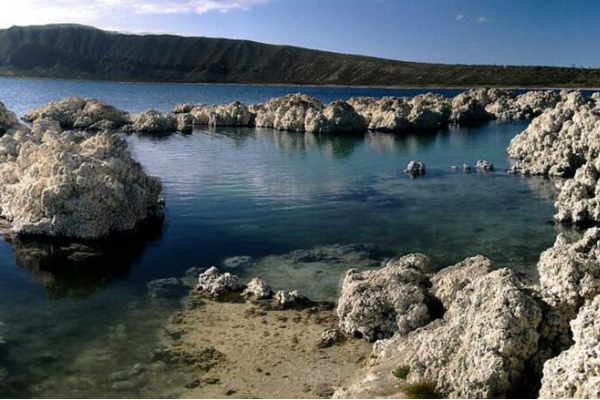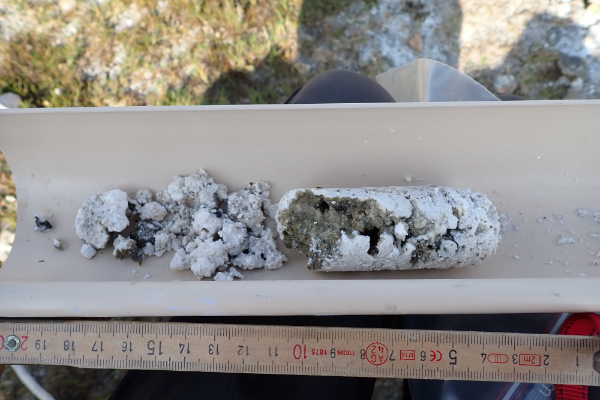Zareth Tinocco PhD thesis
 Linking biogeochemical processes with their isotopic and elemental signals in microbialites from Mexican volcanic crater lakes
Linking biogeochemical processes with their isotopic and elemental signals in microbialites from Mexican volcanic crater lakes
Started in october 2024
Funding: SECIHTI
Supervisors: Christophe Thomazo (UBE) et Rosa Luz Tavera (UNAM)
Abstract
Microbialites are organosedimentary structures, usually calcified, formed through the complex interplay of both environmental parameters and biotic factors (Riding, 2000). They are complex ecosystems, essentially composed of bacteria and/or archaea organized as mats or biofilms (Iniesto et al., 2020). They are widely distributed, from continental aquatic systems to shallow marine settings (Caumartin et al., 2023). Microbialites are among the most productive ecosystems on Earth, with extremely high rates of element cycling, especially C, O and S but also N, Fe, and H (Visscher et al., 2022). Moreover, they represent the oldest undisputed evidence of life on Earth as far back as 3.5 Gyr ago (Allwood et al., 2007) and may provide a blueprint for planetary studies (Horgan et al., 2020).  Many current studies using the ancient microbialite record attempt to define these multiple steps of the history of life. However, they need to rely on modern references closely documenting the links between observables (e.g., chemical, isotopic, mineralogical compositions) that can be archived in the rock record and primary biogeochemical processes that forged these signals, bearing in mind that secondary processes may obviously have also modified them. Consequently, significant scientific efforts have started in the past decades to uncover the processes contributing to formation and growth of microbialites in modern environments.
Many current studies using the ancient microbialite record attempt to define these multiple steps of the history of life. However, they need to rely on modern references closely documenting the links between observables (e.g., chemical, isotopic, mineralogical compositions) that can be archived in the rock record and primary biogeochemical processes that forged these signals, bearing in mind that secondary processes may obviously have also modified them. Consequently, significant scientific efforts have started in the past decades to uncover the processes contributing to formation and growth of microbialites in modern environments.
Keywords
microbialites, biogeochemical processes, biofilms
- extrait:
- lien_externe:
- titre:
- Relier les processus biogéochimiques à leurs signaux isotopiques et élémentaires dans les microbialites des lacs de cratères volcaniques mexicains
- date_de_debut_these:
- octobre 2024
- nom:
- Tinocco
- date_de_debut_these_numerique:
- 202410
- kc_data:
- a:8:{i:0;s:0:"";s:4:"mode";s:0:"";s:3:"css";s:0:"";s:9:"max_width";s:0:"";s:7:"classes";s:0:"";s:9:"thumbnail";s:0:"";s:9:"collapsed";s:0:"";s:9:"optimized";s:0:"";}
- kc_raw_content:
 Linking biogeochemical processes with their isotopic and elemental signals in microbialites from Mexican volcanic crater lakes
Linking biogeochemical processes with their isotopic and elemental signals in microbialites from Mexican volcanic crater lakesStarted in october 2024
Funding: SECIHTI
Supervisors: Christophe Thomazo (UBE) et Rosa Luz Tavera (UNAM)
Abstract
Microbialites are organosedimentary structures, usually calcified, formed through the complex interplay of both environmental parameters and biotic factors (Riding, 2000). They are complex ecosystems, essentially composed of bacteria and/or archaea organized as mats or biofilms (Iniesto et al., 2020). They are widely distributed, from continental aquatic systems to shallow marine settings (Caumartin et al., 2023). Microbialites are among the most productive ecosystems on Earth, with extremely high rates of element cycling, especially C, O and S but also N, Fe, and H (Visscher et al., 2022). Moreover, they represent the oldest undisputed evidence of life on Earth as far back as 3.5 Gyr ago (Allwood et al., 2007) and may provide a blueprint for planetary studies (Horgan et al., 2020).
 Many current studies using the ancient microbialite record attempt to define these multiple steps of the history of life. However, they need to rely on modern references closely documenting the links between observables (e.g., chemical, isotopic, mineralogical compositions) that can be archived in the rock record and primary biogeochemical processes that forged these signals, bearing in mind that secondary processes may obviously have also modified them. Consequently, significant scientific efforts have started in the past decades to uncover the processes contributing to formation and growth of microbialites in modern environments.
Many current studies using the ancient microbialite record attempt to define these multiple steps of the history of life. However, they need to rely on modern references closely documenting the links between observables (e.g., chemical, isotopic, mineralogical compositions) that can be archived in the rock record and primary biogeochemical processes that forged these signals, bearing in mind that secondary processes may obviously have also modified them. Consequently, significant scientific efforts have started in the past decades to uncover the processes contributing to formation and growth of microbialites in modern environments.Keywords
microbialites, biogeochemical processes, biofilms
